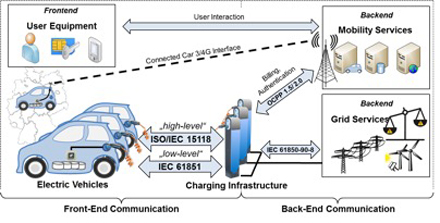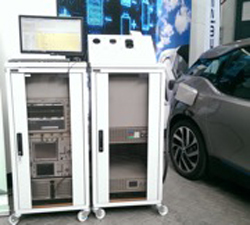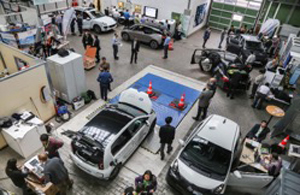|
For
many reasons, electric vehicles are regarded as the key element of a future
environmentally friendly form of mobility, both for individuals but also for
public transport and logistics. Prominent indicators for this trend are the
recent decision of China to mandate a 10% share of electric vehicles sales from
2018 onwards as well as the fully electric van Streetscooter developed by DHL
for logistics applications.

Overview
of E-Mobility communications interfaces and standards (Source: TU Dortmund)
The
increased share of electric vehicles will also challenge the capacity of the
power grid. While a single electric vehicle charged overnight through a
standard plug (typically at around 10 A for AC charging) can be regarded as a
useful complement to provide a continuous load, the parallel fast charging (up
to several 100 A for DC charging per vehicle) of multiple vehicles may easily
lead to overload and instability of the power grid, if not controlled
intelligently.
In
this context, the international specification for vehicle-to-grid
communications developed by the standards groups IEC 61851 and ISO/IEC 15118
play an essential role: they offer so-called “low-level” communication to
provide safe electric connectivity and basic means to control the charging
current depending on the capabilities of the vehicle’s battery and the power
grid.
A
robust PWM (Pulse-Width-Modulation) signal allows for example to adapt the
charging process to the availability of “green energy” from wind parks and
photovoltaic. But only the so-called “high-level” communication of ISO/IEC
15118 allows for sophisticated control options and advanced mobility services
for the so-called Combined-Charging System (CCS), which supports both AC and DC
conductive charging.
As
an example, the so-called “Plug and Charge” feature allows to authenticate the
user’s charging process just by plugging in the vehicle without requiring any
further manual interaction of the user. This is achieved by digital
certificates and a Public Key Infrastructure (PKI). The user may furthermore
specify a dedicated point-in-time until when the vehicle should be charged at a
certain level.
The
grid may then optimize across different vehicles to be charged within a certain
part of the grid in order to avoid overload, apply certain tariff options (e.g.
slower night-time charging vs. fast rush hour charging) and availability of
preferred sources of electric energy. With the aim to integrate communication
and electric power flow as tightly as possible Power Line Communication
(according to the Homeplug Green PHY specification) along the charging cable
has been leveraged for the CCS Vehicle-to-Grid communication.
 |
 |
| Combined-Charging-System-Interoperability
Test System for E-Vehicles (left) and impressions from Testing Symposium at TU
Dortmund University, Germany (right) |
When
defining the requirements for this new control communication for electric
vehicles, representatives of the automotive industry, the utilities sector, and
the information and communications industry work closely together. In order to
avoid that early adopters of electric vehicles are annoyed by malfunctioning
charging processes, an essential success factor is interoperability from day 1.
A
first step to achieve this ambitious goal is the development of conformance
test procedures based on TTCN-3 (Tree and Tabular Combined Notation) within the
ISO/IEC 15118 committee, led by the TU Dortmund University with the
support of the German Federal Ministry of Economic Affairs and Energy.
But
the essential checkpoint for interoperability is provided by a dedicated series
of testing symposia, in which pre-market implementations can be tested by all
interested industry participants in an open but secure environment,
facilitating the process of achieving cross-vendor interoperability.
This
worldwide effort is coordinated by the team of TU Dortmund since 2014 and took
place already 6 times across Europe, the US and Asia. Since 2016 it is supported
by the international Charging Interface Initiative (CharIN, www.charinev.org). The upcoming 7th
CCS testing symposium will take place in Canada in November 2017 (www.testing-symposium.net).
While
the rollout of the combined charging system is ongoing on a large scale, new
charging options, in particular inductive
charging, call for wireless Vehicle-to-Grid communication. Therefore, a new
initiative in the ISO/IEC 15118 standards series addresses an IEEE
802.11n-based communication option. This development ensures that electric
vehicles and the power grid will be able to continue talking also along the
future steps of the E-Mobility (r)evolution. |